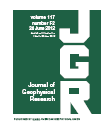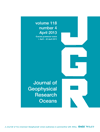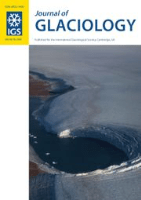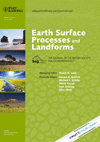
Cryosphere
Scope & Guideline
Charting the Future of Earth's Ice Systems
Introduction
Aims and Scopes
- Glacier Dynamics and Mass Balance:
Research in this area examines glacier behavior, including flow dynamics, mass loss, and interactions with climate variables. This includes studies on glacier surges, calving events, and the impact of temperature changes on glacier mass balance. - Cryospheric Remote Sensing:
Utilizes satellite and airborne remote sensing technologies to monitor and model snow and ice properties, including thickness, albedo, and surface dynamics. This area focuses on improving the accuracy of remote sensing techniques and integrating them with ground-based observations. - Permafrost and Ground Ice Studies:
Investigates the thermal dynamics and hydrology of permafrost, its degradation patterns, and implications for ecosystems and infrastructure. This includes understanding active layer processes and the role of permafrost in carbon cycling. - Sea Ice Processes and Climate Interactions:
Focuses on the physical and biological processes affecting sea ice, including melt dynamics, ice-albedo feedback, and interactions with ocean currents and atmospheric conditions. Research in this area aims to improve predictions of sea ice extent and thickness. - Snow Hydrology and Dynamics:
Explores the physical properties of snow, including accumulation, metamorphism, and melt processes. This research is critical for understanding water resources in snow-dominated regions and the implications of changing snow patterns on hydrology. - Modeling and Simulation of Cryospheric Systems:
Employs various modeling approaches to simulate cryospheric processes, from glacier dynamics to climate interactions. This includes the development of numerical models that integrate physical laws and observational data to predict future changes.
Trending and Emerging
- Impact of Climate Change on Ice Sheets:
Recent publications emphasize the urgent need to understand how climate change is affecting ice sheets, particularly in terms of stability, mass loss, and contributions to sea-level rise. This trend highlights the relevance of ice sheets in global climate models and their feedback mechanisms. - Innovative Remote Sensing Techniques:
There is a marked increase in studies utilizing innovative remote sensing technologies, such as UAVs and advanced satellite systems, to monitor cryospheric changes. This trend showcases the integration of high-resolution data collection methods with traditional approaches. - Modeling of Subglacial Hydrology:
Research focusing on subglacial hydrology and its effects on ice dynamics is becoming increasingly prominent. This area explores the interactions between subglacial water systems and ice flow, which are critical for predicting ice sheet behavior under changing climate conditions. - Cryosphere-Biosphere Interactions:
Emerging studies are investigating the interactions between cryospheric elements and biological processes, particularly regarding how changes in ice and snow affect ecosystems. This includes research on microbial activity in snow and ice and its implications for nutrient cycling. - Socioeconomic Impacts of Cryospheric Changes:
There is a growing emphasis on the socioeconomic implications of changes in the cryosphere, including impacts on water resources, natural hazards, and indigenous communities. This trend reflects an increasing recognition of the need to integrate cryospheric science with societal concerns.
Declining or Waning
- Historical Climate Reconstructions:
Research focusing on historical climate reconstructions using ice cores and sediment records has seen a decrease in recent publications. This may indicate a shift towards more immediate climate impacts and real-time monitoring rather than retrospective analyses. - Traditional Field Studies:
There appears to be a decline in papers emphasizing traditional field studies, as the journal increasingly favors studies that utilize advanced remote sensing and modeling techniques. This shift may reflect the growing capabilities of technology to provide insights that were previously reliant on extensive fieldwork. - Basic Physical Properties of Ice:
Research dedicated solely to the fundamental physical properties of ice, such as its rheological behavior under various conditions, has become less frequent. The focus seems to be shifting towards applications and implications of these properties in larger environmental contexts. - Local Case Studies:
There is a noticeable reduction in the number of publications focusing on localized case studies of ice and snow phenomena. This could suggest a trend towards broader, more generalized studies that apply findings from specific cases to wider contexts.
Similar Journals

Research in Cold and Arid Regions
Fostering collaboration for sustainable environmental engineering.Research in Cold and Arid Regions, published by KEAI PUBLISHING LTD, is a premier journal dedicated to advancing knowledge in the fields of Earth-Surface Processes, Environmental Engineering, and Geosciences. With an ISSN of 2097-1583 and an E-ISSN of 2949-7302, this journal aims to provide a platform for researchers, professionals, and students to share their findings on the complexities of cold and arid environments, which have increasing significance in the context of climate change. The journal holds a Q3 ranking in multiple categories for 2023, reflecting its commitment to quality scholarship, though it also sits at the cusp of enhancing its potential impact in Geotechnical Engineering and Engineering Geology. Open Access options allow for wider dissemination of research findings, ensuring that valuable insights are accessible to a global audience. Based in Beijing, China, the journal is strategically positioned to address the unique challenges faced by arid and cold regions worldwide, making it an essential resource for scholars and practitioners focused on sustainable solutions for environmental issues.

Earth and Space Science
Unveiling the Secrets of Our Planet and Beyond.Earth and Space Science, published by the American Geophysical Union, is a distinguished open-access journal that has profoundly impacted the realms of earth and planetary sciences as well as environmental science since its inception in 2014. With impressive rankings, including Q1 in both Earth and Planetary Sciences and Environmental Science for 2023, this journal ranks 38th out of 195 in the general Earth and planetary sciences category and 51st out of 219 in environmental science, showcasing its commitment to high-quality research dissemination. The journal serves as a vital platform for researchers, professionals, and students, fostering the exploration of critical topics and advancements within these pivotal fields. With an accessible format, researchers can benefit from the rich content available, furthering their knowledge and ensuring that groundbreaking discoveries reach a broader audience. The journal's ongoing commitment to open access aligns with contemporary trends in scholarly communication, emphasizing inclusion and collaboration in tackling pressing global challenges.

Jokull
Unveiling the Secrets of GlaciersJokull is a distinguished journal published by the ICELAND GLACIOLOGICAL SOC, dedicated to advancing knowledge in the field of Earth and Planetary Sciences. Since its inception, Jokull has served as a vital platform for the dissemination of research findings pertaining to glaciology, geomorphology, and related environmental studies, with a rich history spanning from 1980 to 2021. Although the journal's coverage has been discontinued in Scopus, it remains an important resource for academics and practitioners interested in Iceland’s unique geography and climate dynamics. Classified in the Q4 category in the 2023 rankings of Earth and Planetary Sciences, it stands as a testament to the evolving discourse in this vital field of study. Researchers and professionals looking to contribute to or engage with pioneering research are encouraged to explore the insights and findings shared within these pages, even in the absence of open access options. With its headquarters in Reykjavik, Iceland, Jokull continues to facilitate critical discussions and collaborations that shape our understanding of the planet's changing environments.

JOURNAL OF GEOPHYSICAL RESEARCH-EARTH SURFACE
Exploring Earth's Surface Dynamics with Precision.JOURNAL OF GEOPHYSICAL RESEARCH-EARTH SURFACE, published by the American Geophysical Union, stands as a leading voice in the fields of Earth-Surface Processes and Geophysics. With an impressive impact factor placing it in the Q1 category for both disciplines, this journal offers invaluable insights and research findings that address critical challenges related to Earth's surface dynamics and processes. Since its inception in 2004, the journal has been dedicated to fostering a deeper understanding and interdisciplinary exploration of topics critical to environmental science, geology, and geophysics. Researchers and professionals in the field will find cutting-edge studies meticulously peer-reviewed to ensure high quality and relevance, making it an essential resource for academics, practitioners, and students alike. The journal's significant Scopus rankings — 25th out of 179 in Earth-Surface Processes and 26th out of 165 in Geophysics — underscore its influence and the rigor of its content, encouraging submission and engagement from leading scholars globally.

JOURNAL OF GEOPHYSICAL RESEARCH-OCEANS
Pioneering Research in Oceanographic ProcessesJournal of Geophysical Research-Oceans is a premier interdisciplinary journal published by the American Geophysical Union, focused on the dynamic field of ocean sciences. With a rich history dating back to 1986, this journal has become a pivotal platform for researchers, providing a wealth of data and innovative insights into oceanographic processes and their essential role within the Earth's system. The journal enjoys an impressive impact factor and consistently ranks in the Q1 quartile across numerous categories, including Earth and Planetary Sciences and Oceanography, making it a respected source for cutting-edge research and reviews. Notably, it holds significant positions within Scopus rankings, further emphasizing its importance in shaping the scientific discourse surrounding oceanic phenomena. While available through subscription, the Journal of Geophysical Research-Oceans remains an invaluable resource for academics, industry professionals, and students eager to deepen their understanding of ocean dynamics and geophysical interactions.

JOURNAL OF GLACIOLOGY
Exploring the intricate relationships of glaciers and Earth's systems.JOURNAL OF GLACIOLOGY, published by Cambridge University Press, is a leading open-access journal dedicated to advancing the scientific study of glaciers and ice sheets, with a particular focus on their interactions within Earth’s systems. With an ISSN of 0022-1430 and E-ISSN of 1727-5652, this journal has established itself as an influential platform since its inception, currently ranked in the Q1 category of Earth-Surface Processes in 2023. The journal is based in the United Kingdom and has witnessed a convergence of pivotal research from various periods spanning from 1977 through to 2024. It enjoys a commendable Scopus rank of #29 out of 179 in Earth and Planetary Sciences, affirming its impact with an impressive 84th percentile. The open-access model adopted since 2016 enhances its accessibility, enabling a wider audience of researchers, students, and professionals to engage with high-quality research on glaciology, climate change, and environmental systems. By fostering interdisciplinary dialogue and disseminating innovative findings, the JOURNAL OF GLACIOLOGY plays a crucial role in enhancing our understanding of glacial dynamics and their significance in our rapidly changing world.

EARTH SURFACE PROCESSES AND LANDFORMS
Transforming Understanding of Earth’s Surface DynamicsEARTH SURFACE PROCESSES AND LANDFORMS is a renowned academic journal dedicated to the comprehensive exploration of dynamic processes shaping the Earth's surface. Published by Wiley, this esteemed journal has established itself as a leading platform in the fields of Earth and Planetary Sciences, Geography, Planning, and Development. With an impressive Impact Factor and ranked in the Q1 category for multiple disciplines, it consistently features cutting-edge research that contributes to the understanding of geomorphology, hydrology, and related environmental phenomena. Researchers and professionals can benefit from the journal's extensive repository of high-quality studies, making it a crucial resource for advancing knowledge in these vital areas. As it continues to converge from 1981 to 2024, EARTH SURFACE PROCESSES AND LANDFORMS remains pivotal for scholars aiming to engage in high-level discourse and discovery in Earth sciences.

IZVESTIYA ATMOSPHERIC AND OCEANIC PHYSICS
Fostering collaboration for groundbreaking environmental insights.Izvestiya Atmospheric and Oceanic Physics is a distinguished journal dedicated to advancing the fields of atmospheric science and oceanography, published by MAIK Nauka/Interperiodica/Springer. With a rich publication history spanning from 1972 to the present, this journal serves as a vital platform for both theoretical and experimental studies that enhance our understanding of complex atmospheric and oceanic systems. Despite its current categorization in the Q4 quartile according to the 2023 rankings, the journal continues to provide crucial insights, as evidenced by its established ranks in Scopus—placing it in the 15th and 26th percentiles of its respective categories. Researchers, professionals, and students alike are encouraged to contribute to and engage with the latest findings published in this journal, fostering a collaborative spirit within the scientific community dedicated to tackling pressing environmental challenges.

ATMOSPHERIC CHEMISTRY AND PHYSICS
Leading the charge in atmospheric innovation and policy impact.Atmospheric Chemistry and Physics is a leading open-access journal published by Copernicus Gesellschaft mbH, dedicated to advancing the understanding of atmospheric processes and their interactions. With an ISSN of 1680-7316 and E-ISSN of 1680-7324, this journal has been a pivotal resource in the field since its inception in 1999. Based in Göttingen, Germany, it covers a broad spectrum of atmospheric science, providing a platform for original research and reviews that help drive innovation and inform policy. Notably recognized as Q1 in the Atmospheric Science category for 2023, it ranks #8 out of 148 in its field according to Scopus, reflecting its high-quality and impactful contributions. With a commitment to open access since 2001, the journal aims to facilitate widespread dissemination of knowledge, making it readily available to researchers, professionals, and students globally. By fostering the exchange of ideas and findings, Atmospheric Chemistry and Physics plays a crucial role in addressing the pressing challenges related to climate change, air quality, and atmospheric processes.

JOURNAL OF GEOPHYSICAL RESEARCH-ATMOSPHERES
Exploring the dynamics of our planet's atmosphere.JOURNAL OF GEOPHYSICAL RESEARCH-ATMOSPHERES, published by the American Geophysical Union, is a leading peer-reviewed journal dedicated to advancing our understanding of atmospheric science and related disciplines. With an impressive impact factor and consistently holding a Q1 ranking across key categories including Atmospheric Science and Geophysics, this esteemed journal caters to a global audience of researchers, professionals, and students eager to explore groundbreaking studies and insights. The journal covers a comprehensive scope of topics, from climate dynamics to atmospheric processes, enhancing knowledge and informing practices within the realm of Earth and Planetary Sciences. With its strong emphasis on quality research, it remains a vital resource for those engaged in unraveling the complexities of our planet’s atmosphere. Explore this journal to stay abreast of significant developments and foster a deeper understanding in this ever-evolving field.